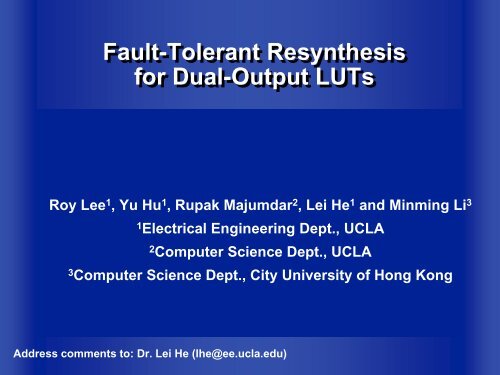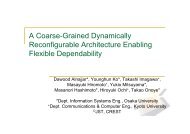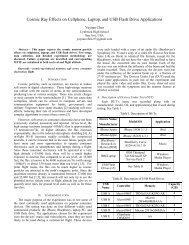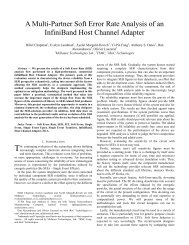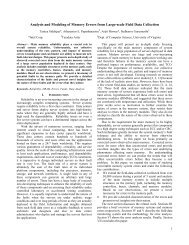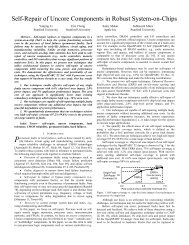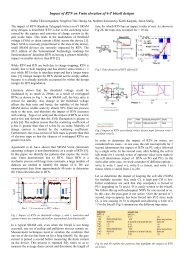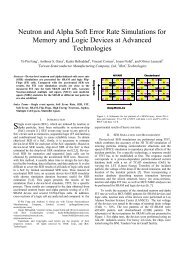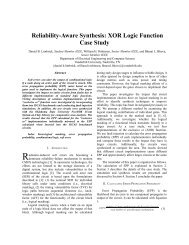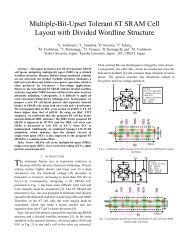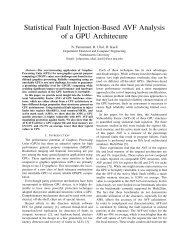Dual-Output
Dual-Output
Dual-Output
You also want an ePaper? Increase the reach of your titles
YUMPU automatically turns print PDFs into web optimized ePapers that Google loves.
Fault-Tolerant Resynthesis<br />
for <strong>Dual</strong>-<strong>Output</strong> LUTs<br />
Roy Lee 1 , Yu Hu 1 , Rupak Majumdar 2 , Lei He 1 and Minming Li 3<br />
1<br />
Electrical Engineering Dept., UCLA<br />
2<br />
Computer Science Dept., UCLA<br />
3<br />
Computer Science Dept., City University of Hong Kong<br />
Address comments to: Dr. Lei He (lhe@ee.ucla.edu)
Outline<br />
• Background and Problem Formulation<br />
• Algorithms<br />
• Experimental Results<br />
• Conclusion and Future Work
The Need for Light-Weight Fault-Tolerance<br />
Mission critical<br />
Mission non-critical<br />
(e.g., aerospace, Sensor NW in battle fields)<br />
(e.g., HDTV, internet router)<br />
Area/performance<br />
Testing/synthesis<br />
Application domains for FPGAs<br />
overhead<br />
cost<br />
TMR Architectural redundancy Multiple configurations Chipwise synthesis<br />
Existing fault tolerant techniques<br />
Scaled CMOS (e.g.
The Need for Light-Weight Fault-Tolerance<br />
Mission critical<br />
Mission non-critical<br />
(e.g., aerospace, Sensor NW in battle fields)<br />
(e.g., HDTV, internet router)<br />
Area/performance<br />
Testing/synthesis<br />
Application domains for FPGAs<br />
overhead<br />
cost<br />
Stochastic synthesis<br />
[Hu:ICCAD’08]<br />
FPGA architectures<br />
aware [Hu:SELSE’09]<br />
Exploration of various<br />
design freedoms (e.g., retiming)<br />
Our Proposal: Light-Weight Fault Tolerance for FPGAs<br />
Scaled CMOS (e.g.
<strong>Dual</strong>-<strong>Output</strong> (DO) LUTs in Modern FPGAs<br />
Xilinx Virtex-5 LUT<br />
Altera Stratix III ALM<br />
• Originally designed to increase the logic density<br />
• Merging two small LUTs into one dual-output LUT
Mechanism of Fault Masking Using DO LUTs<br />
(0 -> 1)<br />
(0 -> 1)<br />
?<br />
LUT#=3<br />
Level=2<br />
LUT#=3<br />
Level=2<br />
Xilinx Virtex-5 dual-output LUT
Potential of the Optimization using DO LUTs<br />
• Spare pins indicate optimization potential.<br />
• Good opportunities for fault tolerance
Fault Modeling<br />
• Assume a stochastic single fault model<br />
At most one fault occurring at a time<br />
A fault with identical random distribution for each SRAM bit<br />
• The criticality of a SRAM bit<br />
Combination of observability and signal probability<br />
Measured by the percentage of input vectors that cause<br />
observable output errors if a fault occurs in this SRAM bit.<br />
• The fault rate of a full-chip is the percentage of input<br />
vectors that cause observable output errors assuming<br />
the single fault.<br />
Fault rate is the average criticality of all SRAM bits
Two Atomic Operators in FT by DO LUTs<br />
Criticality of LUT A<br />
can be reduced<br />
Encoding at<br />
the fanout LUT<br />
`<br />
(a) Original LUTs<br />
Duplication<br />
of a LUT<br />
(b) LUTs after duplication and encoding<br />
• The criticality of LUT A can be reduced after duplication and<br />
encoding<br />
• A duplication and a encoding needs one unused pin,<br />
respectively.
Problem Formulation<br />
Fault-Tolerant using <strong>Dual</strong>-output LUTs<br />
• Given:<br />
a mapped circuit with K-input 2-output LUTs,<br />
• Design freedom:<br />
perform duplication and encoding<br />
• Optimization objective:<br />
the full-chip fault rate is minimized.<br />
Two approaches<br />
Fully masking (FMD): encoding all fanouts<br />
Partial masking (PMD): encoding part of fanouts
FMD Impact on SRAM Criticality<br />
Duplication<br />
Average Crit. = 1.25 Average Crit. = 2.5<br />
Input <strong>Output</strong> Crit.<br />
Input <strong>Output</strong> Crit.<br />
000 0 0.2<br />
000 0 0.2<br />
001 1 0.2<br />
001 1 0.2<br />
010 0 0.4<br />
010 0 0.4<br />
011 1 0.2<br />
011 1 0.2<br />
100 not used 0<br />
100 0 0.2<br />
101 not used 0<br />
101 1 0.2<br />
110 not used 0<br />
110 0 0.4<br />
111 not used 0<br />
111 1 0.2
FMD Impact on SRAM Criticality (cont.)<br />
A<br />
Orig<br />
B<br />
Input <strong>Output</strong> Crit.<br />
Input <strong>Output</strong> Crit.<br />
000 0 0.2<br />
000 0 0<br />
001 1 0.2<br />
001 1 0.2<br />
010 0 0.4<br />
010 0 0<br />
011 1 0.2<br />
011 1 0.2<br />
100 0 0.2<br />
100 0 0<br />
101 1 0.2<br />
110 0 0.4<br />
AND<br />
Encoding<br />
Average Crit. = 2.5 Average Crit. = 0.8<br />
101 1 0.2<br />
Average criticality reduces after duplication.<br />
110 0 0<br />
111 1 0.2<br />
111 1 0.2
FMD Impact on SRAM Criticality (cont.)<br />
Input <strong>Output</strong> Crit.<br />
Input <strong>Output</strong> Crit.<br />
000 0 0.2<br />
000 0 0.2<br />
001 1 0.2<br />
001 1 0.2<br />
010 0 0.4<br />
010 don’t care 0<br />
011 1 0.2<br />
011 don’t care 0<br />
100 not used 0<br />
100 don’t care 0<br />
101 not used 0<br />
110 not used 0<br />
AND<br />
Encoding<br />
Average Crit. = 1.25 Average Crit. = 1.25<br />
101 don’t care 0<br />
Average criticality remains after encoding.<br />
110 0 0.4<br />
111 not used 0<br />
111 1 0.2
FMD ILP Formulation<br />
• Requirement for applying a FMD:<br />
Each of the LUT to be duplicated and its fanout LUTs<br />
must have at least one input pin not occupied<br />
• ILP formulation:<br />
Criticality reduction due to<br />
duplication of LUT L<br />
Decision variables: 1 indicates<br />
duplication of LUT L
Partial Masking-based Duplication<br />
(PMD)<br />
Part of the fanout<br />
LUTs are<br />
encoded<br />
(a) Original LUTs<br />
(b) LUTs after duplication and encoding<br />
• A generalized Full Masking-based Duplication
Experimental Settings<br />
• Benchmarks<br />
Biggest 20 MCNC circuits<br />
Mapped to 6-LUTs by Berkeley ABC<br />
• A LUT-merger algorithm [Ahmed et al, FPGA’07] is<br />
used for area reduction.<br />
• Full-chip fault rate is verified by Monte Carlo<br />
simulation with 5K input vectors<br />
• Three CAD flows are examined
Experimental CAD Flows
MTTF & Area Overhead
MTTF & Performance Overhead
Conclusions and Future Work<br />
• Proposed a novel fault-tolerant<br />
technique using dual-output LUTs<br />
2X MTTF increase w/ 24% area overhead<br />
• In the future, we will consider<br />
Different type of encoding logic<br />
<strong>Dual</strong>-output-aware physical synthesis<br />
which considers interconnects explicitly
Thank you!<br />
Electronic Design Automation Group<br />
Electrical Engineering, UCLA<br />
Website: http://eda.ee.ucla.edu


